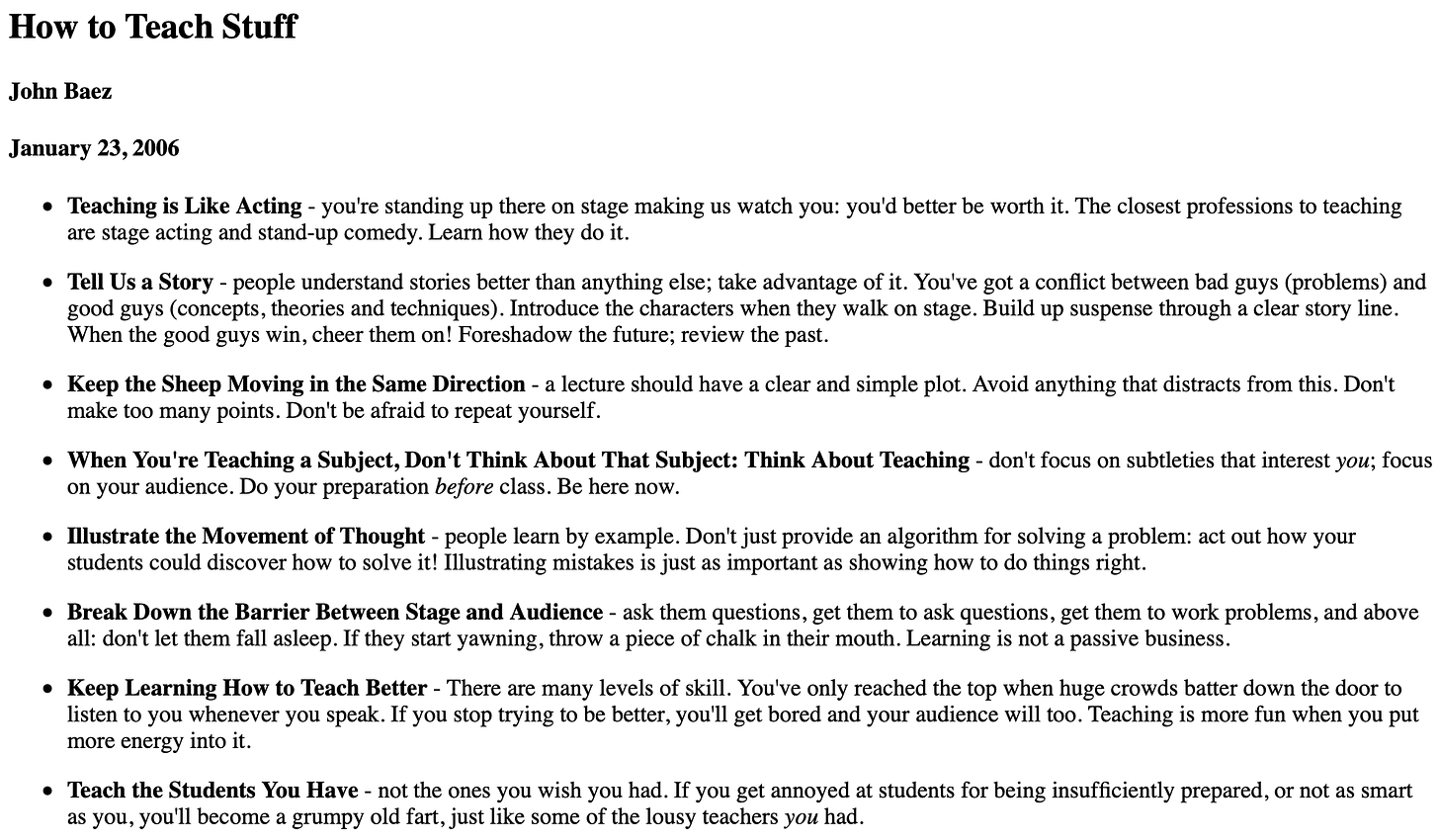Failing Fast (10/25/20)
Hey Friends,
Welcome back to Sunday School, my weekly newsletter to give you a boost in consuming interesting content.
If you haven’t already subscribed, I’d love for you to click this button:
This newsletter is more than just me sharing things that I’ve learned and read. Writing this each week is a way for me to spend time writing and learning. It’s a mechanism that forces me into action each week.
This week I had a lot going on and I didn’t get to this newsletter until the very last minute! I considered skipping a week for the first time ever, but once I sat down to write I knew that would be a mistake.
Even when it’s last-minute, even when it’s something I might not want to do so badly, and even when the quality could be perceived to be less, I still learn something.
And I hope you do as well.
This week, topic #1 is one of my favorite ideas and beliefs. It’s also related to a key flaw in our education system and is something I’d love to try and change in everyone’s mind.
Let’s get to it!

Failing Fast
One of the most negative things school teaches kids is to fear failure. Students are graded using a scale with an “F” is to be avoided at all costs. Of course, we don’t want students producing terrible, lazy, work, but the entire construct of our education system focuses on learning the right answer and avoiding failure.
I’ve adopted the idea of “failing fast” into my personal set of beliefs. I’m a strong advocate that there’s a place for failure in our world. It’s how you move on from that point that is self-defining.
The truth is, perfection is an impossibly lofty goal. In school, you can study and memorize your way to a near-perfect test, but there’s no curriculum or syllabus in life. Because of this, it’s necessary to have a personal trial-and-error system, and that’s what I call failing fast. Failing fast looks like this:
Move quickly (without regard to failure) > Fail > Learn > Adjust
The fear of failure keeps so many people from starting something. It’s one of the biggest barriers I can think of in the entire world. There’s an advantage in life for those who are willing to move quickly. They learn the lessons of inevitable failure before everyone else.
Take a look at what Nike founder Phil Knight says about this topic:
“Fear of failure would never be our downfall as a company. Not that any of us thought we wouldn’t fail; in fact, we had every expectation that we would. But when we did fail, we had faith that we’d do it fast, learn from it, and be better for it.”
The idea of failing fast is so big and can be life-changing if adopted and practiced. Personally, I’ve always been risk-averse and a more methodical thinker, with the intention of avoiding failure. I’ve decided to implement a more balanced attitude by moving quickly and decisively, without regard for failure, in 2020 in an effort to make this part of my life’s ecosystem.
If you’re going to create room for failure, do it quickly, get it out of the way, and respond with positivity for having learned your lesson before everyone else.
Candy as a Business Plan
Halloween is upon us and we’re all about to be eating more candy than we’re willing to admit. Candy has evolved to great heights and has largely left behind one of the OG members of widely distributed candy: the Hershey’s Kiss.
But you know who hasn’t left that behind?
Tesla.
When you think of Tesla you might think of overpriced vehicles that only the rich can afford. And that’s not wrong, that has been true. But it’s part of their business plan and is the strategy they’ve had to take on as they attempt to make electric vehicles affordable for the entire market.
Let’s take a look at the Hershey’s Kiss-shaped business plan that Tesla has been using for years.

Step one was the Tesla Roadster, the first car Tesla released in 2007. That Roadster, and all its subsequent models, had a based price in the ballpark of $100,000.
The profits from selling the Roadster at a high price to the super-rich funded step two: mid-priced, mid-volume cars for pretty rich people. This is where we are today. Tesla’s lineup has expanded to include the Model S, Model X, Model Y, and now the reasonably priced Model 3. Each time Tesla launches new models and gains traction in the market, economies of scale take over and drive prices down. It’s all part of Tesla’s gameplan to get to step three….
The mass production of affordable electric vehicles for the everyone. Tesla is almost there. Today, you can snag a Model 3 for around $30,000 after tax incentives. That’s not too bad!
You can see how this business plan has made sense for Tesla. They’re backing their way into mass-market appeal.
How to Teach
Being a teacher is hard, and it might be harder in 2020 than any other year as teachers try and learn how to do this virtually.
John Baez, famed American math physicist and professor, has some pretty practical answers to help us think about how to teach in the easiest terms possible. Take a look:

A few of my favorite points here:
Baez says that the closest professions to teach are stage acting and stand-up comedy. This means he places more emphasis on delivery and entertainment than anything else about teaching. Teaching is not about the teacher, it’s about the student. And making sure information is delivered to the student in the most memorable, fascinating way is the teacher’s highest responsibility.
Instead of thinking about a subject, a teacher should think about teaching. This means that everything is done through the student’s eyes. Think about what they need to hear and see to learn, not about the subtleties of the subject that interests the teacher.
Teach the students you have. I’m sure all teachers wish they had a different set of students. Perhaps smarter, better supported by parents, or interested in different materials. But teachers need to be prepared to teach all students in practice. Teachers must adjust to fit the mold of their audience.
Creative Ease
Link: Why Walking Helps Us Think - Ferris Jabr
The New Yorker published this article several years ago and it has two profound takeaways regarding creativity:
Scientific studies clearly prove that walking has an impact on our ability to be creative. Getting up and moving around helps us come up with ideas.
Inversely, if you are looking for a single correct answer to something it is better to be seated for laser-focused thinking.
The same studies that show us that walking and movement are conducive to better creativity also show us that sitting is better for narrowed in problem-solving. Walking creates an environment where lots of ideas can bubble up to the surface, all of them ideas worth exploring. If you’re looking for a single correct solution to a problem, you probably don’t want this.
Working from home gives us even more control over our environment and working style than ever. Use these tips to your advantage and plan walks accordingly!
Quote of the Week
"Don’t tell people how to do things, tell them what to do and let them surprise you with the results.” -Phil Knight
That’s all for this week, thanks for attending!
If you want to share this with someone just forward away or click this button:
See you next week,
-Ryan Mulholland


